Por favor, use este identificador para citar o enlazar este ítem: http://hdl.handle.net/10259/9798
Título
Development of mouse models of angiosarcoma driven by p53
Autor
Publicado en
Disease Models & Mechanisms. 2019, V. 12, n. 7
Editorial
The Company of Biologists
Fecha de publicación
2019-06
ISSN
1754-8403
DOI
10.1242/dmm.038612
Resumen
Angiosarcomas are a rare group of tumours which have poor prognosis and limited treatment options. The development of new therapies has been hampered by a lack of good preclinical models. Here, we describe the development of an autochthonous mouse model of angiosarcoma driven by loss of p53 in VE-cadherin-expressing endothelial cells. Using Cdh5-Cre to drive recombination in adult endothelial cells, mice developed angiosarcomas with 100% penetrance upon homozygous deletion of Trp53 with a median lifespan of 325 days. In contrast, expression of the R172H mutant p53 resulted in formation of thymic lymphomas with a more rapid onset (median lifespan 151 days). We also used Pdgfrb-Cre-expressing mice, allowing us to target predominantly pericytes, as these have been reported as the cell of origin for a number of soft tissue sarcomas. Pdgfrb-Cre also results in low levels of recombination in venous blood endothelial cells in multiple tissues during development. Upon deletion of Trp53 in Pdgfrb-Cre-expressing mice (Pdgfrb-Cre, Trp53fl/fl mice), 65% developed lymphomas and 21% developed pleomorphic undifferentiated soft tissue sarcomas. None developed angiosarcomas. In contrast, 75% of Pdgfrb-Cre, Trp53R172H/R172H mice developed angiosarcomas, with 60% of these mice also developing lymphomas. The median lifespan of the Pdgfrb-Cre, Trp53R172H/R172H mice was 151 days. Re-implantation of angiosarcoma tumour fragments from Cdh5-Cre, Trp53fl/fl mice provided a more consistent and rapid model of angiosarcoma than the two spontaneous models. The ability to passage tumour fragments through the mouse provides a novel model which is amenable to preclinical studies and will help the development of potential new therapies for angiosarcoma.
Palabras clave
Angiosarcoma
TRP53
Genetically engineered mouse model
Lymphomas
Tumour
Materia
Oncología
Oncology
Salud
Health
Medicina
Medicine
Versión del editor
Aparece en las colecciones










